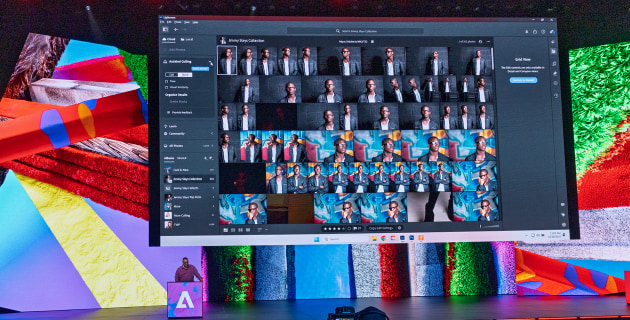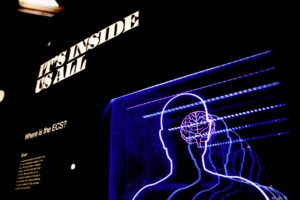
Adobe’s message from the MAX 2025 keynote in Los Angeles was loud and clear: AI is no longer just a generative tool; it’s your new creative assistant. The company unveiled a sweeping set of updates across its Creative Cloud suite, centered on ‘agentic AI’ you can actually talk to (or at least text), a major new Firefly model, and deep integrations with third-party AI – including technology from Google and Topaz Labs.
This development follows the rapid mainstream adoption of AI technologies, which have drastically altered the landscape of digital creativity. The announcement represents a significant leap towards making AI a more integral part of creative workflows, similar to the way the computer mouse revolutionized user interfaces in the 1980s.
Revolutionizing Creative Workflows with AI
Consider the humble computer mouse, invented by Douglas Engelbart in 1963. It took over 20 years to become mainstream in the early 1980s, fundamentally changing how we interact with computers. Fast forward to 2025, and AI has achieved mainstream status in just a couple of years, transforming the way we engage with digital tools. The mouse isn’t obsolete, but now we can literally tell our software what we want it to do.
Text prompting has been integrated on multiple levels, promising to enhance efficiency and reduce post-production time. This shift is evident in Adobe’s latest updates, which include AI-assisted culling in Lightroom and Lightroom Classic, a long-awaited feature for photographers.
AI-Assisted Culling in Lightroom
For photographers, the Adobe MAX Keynote’s ‘wow’ moment was the introduction of AI-assisted culling to Lightroom and Lightroom Classic. This feature has been on photographers’ wishlists for some time, and its implementation is a significant milestone.
AI-assisted culling works by analyzing a shoot – say, 3000 images – and using simple checkboxes and sliders to automatically reject misfires, blinking shots, and unfocused or poorly exposed images. For technically good images, the ‘stacking’ function identifies similar shots, such as bursts from a sporting event or a series of portraits, and selects the best one while stacking the rest underneath. This feature is a boon for sports and wedding photographers who need to deliver hero shots quickly.
Innovations in Image Manipulation
Another impressive feature unveiled during the Adobe Illustrator segment is derived from the ‘Project Turntable’ sneak peek. This technology allows users to rotate a 2D vector image by letting AI deduce what the object looks like from different angles, effectively transforming it into a 3D object. This capability is now being applied to photography.
Photographer Terry White demonstrated this by using AI to adjust a portrait in Photoshop. By selecting Google’s Gemini 2.5 model, he prompted the software to ‘turn him forward and maintain his disposition,’ resulting in a forward-facing portrait that retained the subject’s original appearance. This raises questions about the nature of photographic authenticity in the age of AI.
Expanding the Creative Possibilities
Adobe’s updates also include a new ‘Colour Variance’ slider, which quickly adjusts uneven skin tones in portraits, and the ability to create 4K slideshows, addressing a long-standing limitation of 1080p resolution.
Other notable updates include Leica tethering, auto dust spot removal, more filters for Library and Smart Collections, and various performance enhancements. These updates reflect Adobe’s commitment to enhancing user experience and expanding creative possibilities.
The New AI Assistants
The standout feature of the keynote was the introduction of new AI Assistants in beta for Photoshop and Adobe Express. These assistants transform Adobe’s AI from simple text-prompt generation into a conversational, ‘agentic’ experience. Users can now instruct the assistant in plain language to perform complex and repetitive tasks, streamlining workflows significantly.
During a demo, a user typed, ‘Rename all my layers based on my content,’ and the AI organized the file. Other commands, such as “make the background look like a sunset and harmonize the lighting,” were executed in seconds. The assistant also offers personalized recommendations and tutorials to help complete projects.
Firefly Evolves: A New Era of Multimedia Creation
Adobe’s core generative AI, Firefly, received its most significant update yet, expanding beyond still images into a full multimedia creation studio. The Firefly Image Model 5, now in public beta, produces more photorealistic images at a native 4-megapixel resolution, offering greater detail and a new “Prompt to Edit” feature for precise image edits using text.
Additionally, Firefly now includes tools like ‘Generate Soundtrack’ for creating custom, royalty-free music, and ‘Generate Speech’ for realistic, multilingual voiceovers in partnership with ElevenLabs. A new web-based Firefly Video Editor, currently in private beta, was also announced, allowing creators to generate, organize, and sequence video clips in one place.
Photoshop and Premiere Pro Enhancements
Photoshop’s Generative Upscale feature, powered by Topaz Labs, allows users to upscale low-resolution images to 4K with realistic detail. The popular Harmonize feature, which matches the color, lighting, and shadows of a composited object to its new background, is now fully integrated into Photoshop.
Premiere Pro introduces the AI Object Mask, a public beta feature that automatically identifies and isolates people or objects in a video, creating a trackable mask. This innovation eliminates hours of manual rotoscoping for color grading, blurring, or applying effects to specific parts of a shot.
Adobe also launched a free, watermark-free video editing app, Premiere on iPhone, and announced a partnership with YouTube for a “Create for YouTube Shorts” space, enabling mobile creators to edit with professional tools and publish directly to the Shorts platform.
An Open Ecosystem and Future Innovations
Underpinning these announcements is Adobe’s new, more open strategy. By integrating partner models from Google, Topaz Labs, ElevenLabs, OpenAI, and Runway, Adobe is positioning Creative Cloud as a central hub for all the best AI tools, not just its own.
The company also hinted at future technologies, including Project Moonlight, an AI assistant designed to work across all Adobe apps and learn from a user’s assets, and Project Graph, a node-based tool for building and automating complex creative workflows.
As Adobe continues to innovate, the implications for creative professionals are profound. The integration of AI into the Creative Cloud suite not only enhances efficiency but also broadens the scope of what is creatively possible, setting the stage for a new era in digital artistry.







